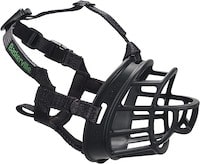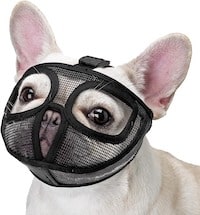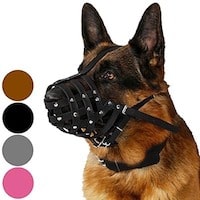Generally, not every dog is violent; likewise, not every dog portrays friendly behaviour. There is a common question that dog lovers have in the UK – What dogs have to be muzzled in UK? The question makes sense. Because when it comes to dogs, there are plenty of laws protecting the rights of people but nothing specific regarding restraints and muzzles in the UK.
So, if you are a dog lover, or owner or considering having one then this article is for you. Here you’ll get some valuable insights into what dogs have to be muzzled in the UK. But, before we do that, let’s briefly understand what a dog muzzle is.
Dog Muzzle: a piece of equipment that covers a dog’s mouth. A dog muzzle is generally helpful in preventing dogs from biting. They have holes that easily allow dogs to breathe.
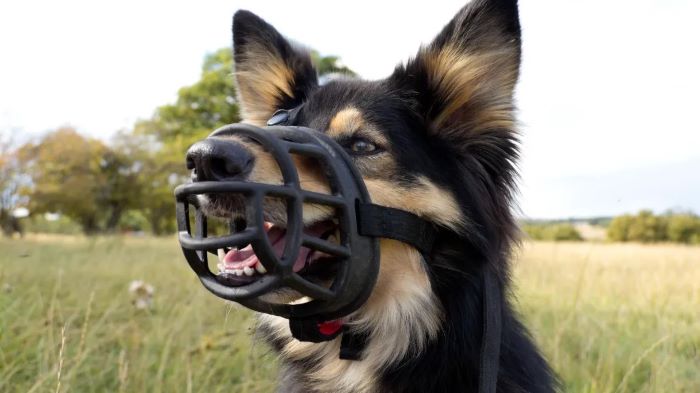
You Might Also Like:
What dogs have to be muzzled in UK?
There is no specific law that mandates putting a muzzle on a dog in the UK. But, the guidelines in the dangerous dogs act 1991 UK gov, there are a few aspects to consider. As per section 7 of the act, two significant things were:
- The muzzle must be tight enough to prevent dogs from biting another person
- The dog must securely be held on a lead by a person who is not less than 16 years old
Further, there are 10 other sections related to the act. The first section also mentions the breed of dogs one should not own. Owning a Pit Bull Terrier, Japanese Tosa, or any other fighting dog such as Dogo Argentino and the Fila Brasileiro is illegal in the UK. Also, it’s the owners’ responsibility to confirm whether their dog is banned or not.
But, why a dog has to wear a muzzle?
We saw the legal aspect of why dogs have to wear a muzzle. Here are some additional reasons signifying why dogs should wear them:
- The habit of biting people
If your dog has a tendency to bite people regularly, then you should certainly get them to wear a muzzle. Doing so will help you avoid any biting incidents while you go out in public.
- Get stressed around strangers
It’s possible your dog may feel uncomfortable or get fearful around strangers. They act on this impulse and end up biting another individual, so, you’ll need to use the muzzle for everyone’s safety.
- The dog is under training
Many dogs are professionally trained for a specific duty or purpose. Their normal behaviour is aggressive and a muzzle is a useful behaviour modification tool to manage their aggression.
- Aggressive and Constant Barking
If the dog is aggressive and barks constantly, using a muzzle becomes a necessity. This will help keep them in control and avoid barking.
- Recovering from an injury
Generally, when your dog is recovering from an injury, the chances of him biting another person are high. This happens as they consider other strangers as a threat and bite them in an act of defending themselves. Regardless, of the psychology behind the intent, putting on a muzzle for your inured dog is not a bad choice.
Types Of Muzzle
If you are thinking – about what type of muzzle is suitable for your canine friend, the following are different types of muzzle for your canine friend.
Basket Muzzle
This muzzle looks like a basket and is strapped around the dog’s mouth. It’s made of leather, plastic, wire or rubber. Their appearance may give an unpleasant feeling, or feel inhumane. But, dogs feel comfortable in a basket muzzle.

The majority of basket muzzles easily allow dogs to drink and eat. In fact, a few of them have slits, so, you can also provide large treats without removing the muzzle. These types of muzzles are suitable for a longer duration.
Nylon Muzzle
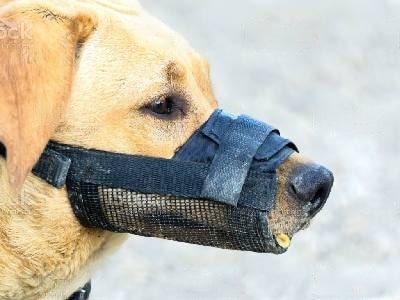
A nylon muzzle also known as a soft muzzle is made of nylon, mesh or leather. They are made of soft material but are tight around the snout of the dog. The mouth is completely closed. This muzzle is potentially dangerous and less comfortable for your canine friend. Here is why:
- Causes sweating around the snout
- No barking, drinking or eating
If used for longer periods, can cause issues for dogs.
These were the two main types of muzzles. You have a rough idea of which one suits your dog. But, it’s also important to find the best fit for your dog. So, how will you do that? Let’s find out.
Selecting the most suitable muzzle for the dog
Before you get a muzzle, it’s best you consult a professional trainer for getting insights into different types and sizes. Try out different sizes of muzzles and pick the best dog muzzle for the dog.
#1 Define the purpose
You have to define the purpose or find a specific reason to use a muzzle on your dog. You can’t just randomly decide that your dog will wear a muzzle. This means, deciding whether you are using it while going for a walk, for training, or visiting a specific place.
#2 Basket or Nylon
This mainly relies on how long you plan on putting the muzzle on. For the long term, you can pick the basket muzzle and for the short term, you can use Nylon.
Fit the Muzzle in a Dogs Mouth
Often dog owners skip this part, measuring and fitting the muzzle is the most crucial and challenging task. Too loose and your dog will remove it, if too tight, the dog will have difficulty breathing, drinking or cause excessive panting.
Before starting muzzle training, be sure you have the right size muzzle for your dog. Learn how to measure a dog for a muzzle.
So, how to fit the muzzle properly?
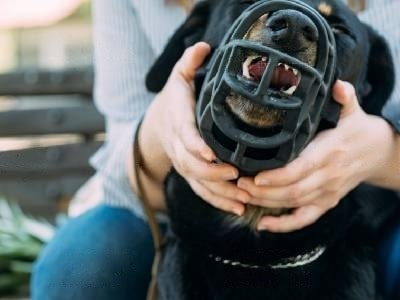
Fit the straps. Maintain a one-finger gap between the finger and the dog’s head. Before you get a muzzle, it’s best you consult a professional trainer for getting insights into different types and sizes. Try out different sizes of muzzles and pick the best one for the dog.
When you select the muzzle that suits your dog, it’s not the end. You have to train them and get them accustomed to the thing.
Muzzle Training For Dogs
You cannot put on a muzzle on a dog any time you want. Preparing the dog mentally is important. Here are some ways you can do it:
1. Start with a treat
Before offering a treat to your dog, put the muzzle near them. Let the dog sniff the muzzle. After they sniff, put the treat. Repeat this procedure a few times.
The treat alongside the muzzle registers a positive response in dogs’ minds and as a result, you’ll observe a shift in dogs’ behaviour. They will acknowledge the muzzle as it reminds them of the treats they had.
2. Put on the muzzle with treat
Once your dog feels good about the muzzle, use this to put them on their snout. You can tempt them by using treats. Put the muzzle near their nose and treat behind the muzzle.
When you do this, you’ll see they are trying to reach out towards the treat, you can use this to your benefit and gently slide the muzzle onto their nose. Afterwards, you can allow them to finish their treat.
3. Put on the muzzle without a treat
It’s time to try it without using the treat as bait. So, this time you just put the muzzle instead of the treat and wait for the dog to place the mouth in the muzzle.
If the dog puts the mouth in the muzzle, wait for some time and if their behaviour remains good offer the treat afterwards.
4. Associate a phrase with the muzzle-wearing event
If your dog is wearing the muzzle without resistance, you need to pick a phrase. Use it while they put their mouth in the muzzle, this will help them remember the event. Now every time you say the phrase, they will associate it with the muzzle-wearing event.
5. Securing the collar
Seuring the muzzle collar may take a while. The key is to remain patient while executing this final step. You can do this by gradually increasing the holding time of the collar while your dog has a treat with the muzzle on.
When Should You Avoid The Muzzle?
As we keep mentioning, you cannot randomly choose to use a muzzle. If you are using them just to tackle barking, chewing or other small behavioural issues, then it’s definitely not a good practice.
Behavioural issues such as barking and chewing are natural. A muzzle is only going to help in the short term. For long-term solutions, you will have to train your dog and use behaviour modification techniques.
Enforcing the muzzle on your dog can have a stressful impact on the dog. For instance, you see other dog owners taking their dogs into the park. But, Your dog doesn’t fancy going to the park. If you use the muzzle for taking the dog to the park, it will upset them.
What’s even worse is if you continue using a muzzle when not required, the dog will get used to it. It will not go out without the muzzle on.
FAQs
When should I muzzle my dog in the UK?
There is no mandatory requirement for muzzling the dog in the UK. However, there are few dogs that are not allowed in the UK. Pit Bull Terrier, Dogo Argentina, Fila Brasileiro, and Japanese Tosa are the ones not allowed.
What Dogs Have to Be Muzzled in UK?
The following breeds need to be muzzled in public: Bull Terrier, Doberman Pinscher, German Shepherd Dog (and related breeds), Rottweiler, Mastiffs including the Bull Mastiff, Cane Corso, and Dogue De Bordeaux. Also, crosses of any of the mentioned breeds.
Which dogs need muzzling in the public?
keeping fighting dogs or one’s with aggressive behaviour is recommended. The Pit Bull Terrier.
The Dogo Argentino, The Fila Brasileiro, and The Japanese Tos are the prominent ones that are to be muzzled in the public.
Are dogs allowed to roam free in the UK?
It’s against the law to allow the dog to roam free and be in a public place without any supervision. In fact, the government also indicates that a dog must not roam around freely on neighbour’s property, and to some extent in their own house as well.
Final Comment on What Dogs Have To Be Muzzled In UK?
Using the muzzle in the UK is not mandatory but, it’s a good practice if you use them in public places. We say this because there is no predicting when your dog gets out of control. Also, if it is aggressive by nature, or has extreme behavioural issues it’s recommended to use them. However, it’s also important you don’t make them a habit for your dog. It can have heavy repercussions on their mental health.
Muzzling in public places can be a responsible choice for aggressive or problematic barkers. But it’s critical not to over-rely on muzzling as a solution. For more understanding when barking legally becomes a nuisance requiring action, check our guide on when is dog barking considered a nuisance.
